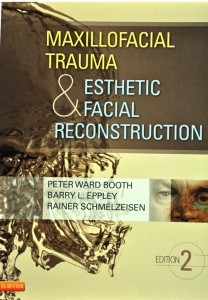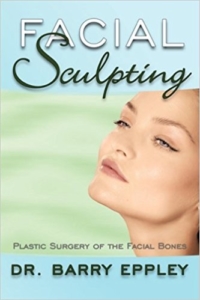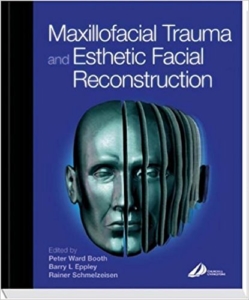Books
Books
 The second edition of MAXILLOFACIAL TRAUMA AND ESTHETIC FACIAL RECONSTRUCTION was released in late October 2011. It is a follow-up addition to the very popular first edition by the same name that was initially released in 2003. Since no one surgeon has a monopoly on the wisdom and experience of every aspect of facial trauma, this new edition brings together input from 57 authors from plastic surgery, maxillofacial surgery, otorhinolaryngology and ophthalmology in 33 chapters. Covering the broad topics of Principles, Definitive Management, Secondary Surgery and Innovations, the texts covers the entire scope of the treatment of facial injuries up through secondary revisions which are the norm and not the exception. Dr. Barry Eppley, Indianapolis plastic and maxillofacial surgeon, personally either wrote solely or made major contributions nearly 1/3 (ten chapters) of the book. Covering the topics of Etiology and Prevention of Craniomaxillofacial Trauma, Medicolegal Implications of Facial Injuries, Principles of Facial Soft Tissue Injury Repair, Alloplastic Biomaterials for Facial Reconstruction, Surgical Access, Nasal Fractures, Primary Repair of Facial Soft Tissue Injuries, Reconstruction of Large Hard and Soft Tissue Loss of the Face, Facial Burns and Secondary Rhinoplasty for Traumatic Nasal Deformities, Dr. Eppley shared his broad experience in this field as a double-board certified Plastic and Oral and Maxillofacial Surgeon.
The second edition of MAXILLOFACIAL TRAUMA AND ESTHETIC FACIAL RECONSTRUCTION was released in late October 2011. It is a follow-up addition to the very popular first edition by the same name that was initially released in 2003. Since no one surgeon has a monopoly on the wisdom and experience of every aspect of facial trauma, this new edition brings together input from 57 authors from plastic surgery, maxillofacial surgery, otorhinolaryngology and ophthalmology in 33 chapters. Covering the broad topics of Principles, Definitive Management, Secondary Surgery and Innovations, the texts covers the entire scope of the treatment of facial injuries up through secondary revisions which are the norm and not the exception. Dr. Barry Eppley, Indianapolis plastic and maxillofacial surgeon, personally either wrote solely or made major contributions nearly 1/3 (ten chapters) of the book. Covering the topics of Etiology and Prevention of Craniomaxillofacial Trauma, Medicolegal Implications of Facial Injuries, Principles of Facial Soft Tissue Injury Repair, Alloplastic Biomaterials for Facial Reconstruction, Surgical Access, Nasal Fractures, Primary Repair of Facial Soft Tissue Injuries, Reconstruction of Large Hard and Soft Tissue Loss of the Face, Facial Burns and Secondary Rhinoplasty for Traumatic Nasal Deformities, Dr. Eppley shared his broad experience in this field as a double-board certified Plastic and Oral and Maxillofacial Surgeon.
 Everyone knows the phrase…’beauty is skin deep but ugly goes to the bone’. While commonly said, this phrase is only partially correct. Beauty is also bone deep as the outward appearance of the face begins down at this foundational level. How the face looks at the outside has a lot to do with how it is shaped on the inside. Any forensic scientist can attest to it. Many have seen on TV shows how an unidentified corpse’s face is ‘rebuilt’ with clay layers on top of the skull and facial bones based on established soft tissue measurements. Like a roof on a house, the outer appearance of the face is highly influenced by the shape of the bone underneath it.
Everyone knows the phrase…’beauty is skin deep but ugly goes to the bone’. While commonly said, this phrase is only partially correct. Beauty is also bone deep as the outward appearance of the face begins down at this foundational level. How the face looks at the outside has a lot to do with how it is shaped on the inside. Any forensic scientist can attest to it. Many have seen on TV shows how an unidentified corpse’s face is ‘rebuilt’ with clay layers on top of the skull and facial bones based on established soft tissue measurements. Like a roof on a house, the outer appearance of the face is highly influenced by the shape of the bone underneath it.
Treating facial bone problems has a long history in plastic surgery. Since World War I, when trench warfare created a large number of severe facial injuries (sticking your head up out of a trench was usually not a good idea), plastic surgeons have been rebuilding, rearranging, and enhancing facial bones. Today’s plastic surgeons pay particular attention in cosmetic surgery to how the skin, fat and muscle of the face redrapes over the bones, knowing full well its influence on the final shape. Whether it is a facelift, nose job,or making one’s face more masculine, being aware of and changing the shape of the bone can lead to a better balanced and more attractive face.
Facial bone changes can be done by building the bone up with synthetic implants, or in some cases, actually moving select facial bones themselves. A remarkable array of changes in the forehead, nose, cheeks, midface, lower jaw and chin are now possible.
Dr. Barry Eppley, board-certified plastic surgeon of Indianapolis, takes you down deep inside the face on a tour of its palpable architecture. Learn how many of the commonly known, and some less commonly known, cosmetic facial bone procedures work and help make for more beautiful faces.
INSIGHTS FROM ‘BEHIND THE NEEDLE’
 In the past, plastic surgery was all about having operations to reverse the effects of aging on the face. Time was, once you could no longer stand to see yourself in the mirror or in pictures…facelifts, eye tucks and the like became appealing with all of the associated swelling and bruising, recovery, and expense.
In the past, plastic surgery was all about having operations to reverse the effects of aging on the face. Time was, once you could no longer stand to see yourself in the mirror or in pictures…facelifts, eye tucks and the like became appealing with all of the associated swelling and bruising, recovery, and expense.
Over the past ten years, non-surgical injectable treatments have become popular for men and women of all ages…and have become part of mainstream society in ways that rival Starbucks, energy drinks, and iPhones. The concepts of muscle paralysis, plumping fillers, and fat dissolving agents have made it possible to have smooth foreheads, fuller lips and softer laugh lines, and maybe some subtle tightening of the jowls and neck in a few simple visits to the doctor’s office. Unlike surgery, injectable facial treatments are as much about the prevention of the effects of aging as they are about reversing what has already taken place.
Along with this explosion of available injectable treatments have come the inevitable, unbelievable marketing claims, and so-called ‘expert’ injectors. But, like much of what you may read on the internet, in popular magazines, and hear in commercials , what can you really believe? How do you separate reality from marketing hype? How can you decide where-or if-injectable treatments are for you? And if so, which ones??
Dr. Barry Eppley, board-certified plastic surgeon of Indianapolis, takes you on a broad tour of every injectable treatment option. Providing insight into Botox®, the many injectable fillers, and lipodissolve, Dr. Eppley provides the current science behind the treatments, and talks plainly about his experience and observations. These insights from ‘behind the needle’ about these incredibly popular injectable treatments are available nowhere else.
Whether you are just researching Botox® or fillers, or are a seasoned expert with an upcoming consultation about the next new option, Dr. Eppley gets you ready for Injecting Youth!
 Plastic surgery continues to grow in popularity as evidenced by the statistics from the American Society of Plastic Surgery over the past decade. Surgical procedures as well as non-surgical cosmetic office treatments have increased every year since 2000. With the explosion of the internet and other communication mediums, a tremendous amount of information about plastic surgery is available at the click of a mouse from anywhere in the world.
Plastic surgery continues to grow in popularity as evidenced by the statistics from the American Society of Plastic Surgery over the past decade. Surgical procedures as well as non-surgical cosmetic office treatments have increased every year since 2000. With the explosion of the internet and other communication mediums, a tremendous amount of information about plastic surgery is available at the click of a mouse from anywhere in the world.
But like much on the internet, news magazines, and product brochures, what can you believe? How do you separate reality from the marketing hype? How can you decide what are the best treatment options for your facial concerns?
Dr. Barry Eppley, board-certified plastic surgeon of Indianapolis, takes you on a tour of facial plastic surgery. Covering dozens of the most popular cosmetic surgeries and treatments of the face, Dr. Eppley talks plainly about his experience and observations. From facelifts and nosejobs to injectable fillers, Dr. Eppley writes from his own extensive plastic surgery experience of the face, and provides insights into what many cosmetic procedures are, and what they actually do.
The desire to feel beautifully confident at any age is a natural one. Seeking plastic surgery ‘assistance’ is not vain or trivial. It is a major decision that requires forethought and preparation. Whether you are still considering if plastic surgery is right for your face, have an upcoming consultation with a plastic surgeon, or are planning a procedure in the future, Dr. Eppley prepares you to ask better questions and Face The Facts!
This book has been written to provide a basic education and awareness of the surgical specialty of Maxillofacial Surgery. It is not designed to be an all- inclusive text, but an outline of the terminology, anatomy, diagnosis, and treatment of the broad and complex array of maxillofacial and craniofacial problems. It is intended to serve as a pocket guide that is visually- oriented, can be quickly used as a reference, and read from cover to cover in a short period of time.
Maxillofacial surgery, a long-standing subspecialty of Plastic Surgery, had its beginnings in the early part of the 20th century during World War I when trench warfare created a large number of severe facial injuries. Their treatment required the development of an integrated approach of reconstructive surgery and dentistry which remains the guiding principles of Maxillofacial Surgery today. It has grown from its beginnings in facial trauma to include congenital cleft and craniofacial deformities, jaw surgery, reconstruction of extirpated tumor defects, to aesthetic facial surgery.
Maxillofacial surgery requires an understanding and assimilation of medical and dental principles involving anatomy, biomaterials, and manual dexterity. Surgical manipulation of facial anatomy is unforegiving in its visible outcome to the patient and society.
The specialty of Maxillofacial Surgery combines a knowledge base and techniques drawn from all of the head and neck disciplines with particular emphasis coming from plastic surgery. The field has expanded greatly over the latter half of the 20th century, led primarily by the interest and innovations established by the tenets of contemporary craniofacial surgery where maxillofacial surgery was expanded to the orbits, forehead, and the cranial cavity to make a better life possible for many congenitally deformed but intelligent human beings.
The specialty of Maxillofacial Surgery is designed to provide the highest standards of care for all surgery performed in the face and skull, whether it’s origin be of bone, soft tissue, or both. It can be difficult work in an anatomic area where many essential functional and aesthetic structures intermingle and proper training of the surgeon is paramount to achieve the desired end result, a patient with a more normal face and smile. It endeavors to achieve these aims through education, research, and awareness amongst the general public and medical field about the specialty. This handbook, in its own small way, is another brick for that building. May its reading provide insight into the astonishing work possible from Maxillofacial Surgery.
Dr. Barry Eppley
 Published in 2003 with co-authors Dr. Peter Ward-Booth (United Kingdom) and Dr. Rainer Schmelzeisen (Germany), Dr. Eppley co-authored this now classic textbook entitled Maxillofacial Trauma and Esthetic Reconstruction. In a single volume, the comprehensive topic of the management of bone and soft tissue injuries to the face was done in just over 650 pages with 33 chapters and more than 500 color illustrations.
Published in 2003 with co-authors Dr. Peter Ward-Booth (United Kingdom) and Dr. Rainer Schmelzeisen (Germany), Dr. Eppley co-authored this now classic textbook entitled Maxillofacial Trauma and Esthetic Reconstruction. In a single volume, the comprehensive topic of the management of bone and soft tissue injuries to the face was done in just over 650 pages with 33 chapters and more than 500 color illustrations.
Bone and soft tissue facial trauma is one of the three major areas in the field of maxillofacial surgery. Having its origins in World War I and II from the last century where many facial injuries occurred, the need for specialized surgery methods for facial reconstruction began. It has now evolved into very sophisticated technologies for bone fixation and movement (plates and screws) as well as replacement of missing soft tissues. (pedicled and free flap transfers) The ‘high-rent’ district of the face allows the need for numerous medical specialities to participate including ophthalmology, neurosurgery, radiology, and dentistry in addition to the classic three surgical specialities of maxillofacial, plastic and otolaryngologic surgery. This book does an excellent job of bringing the knowledge base of all such disciplines together in a single concise volume.
One of the real strong points and emphasis in the book is what most facial trauma books historically lack, reconstruction of secondary facial defects. Despite the best surgical techniques and equipment, not all facial trauma patients end up with perfect results. Beyond simple lacerations and isolated bone fractures, the injury pattern of many facial trauma patients is complex and the best outcome will usually defy a single surgical effort. From scar revisions to occlusal discrepancies to soft tissue deficiences, secondary reconstruction of facial trauma is not rare and the book spends about as much time on those topics as that of primary repair.
This book is now undergoing a 2nd edition which should be forthcoming in the fall of 2011.

